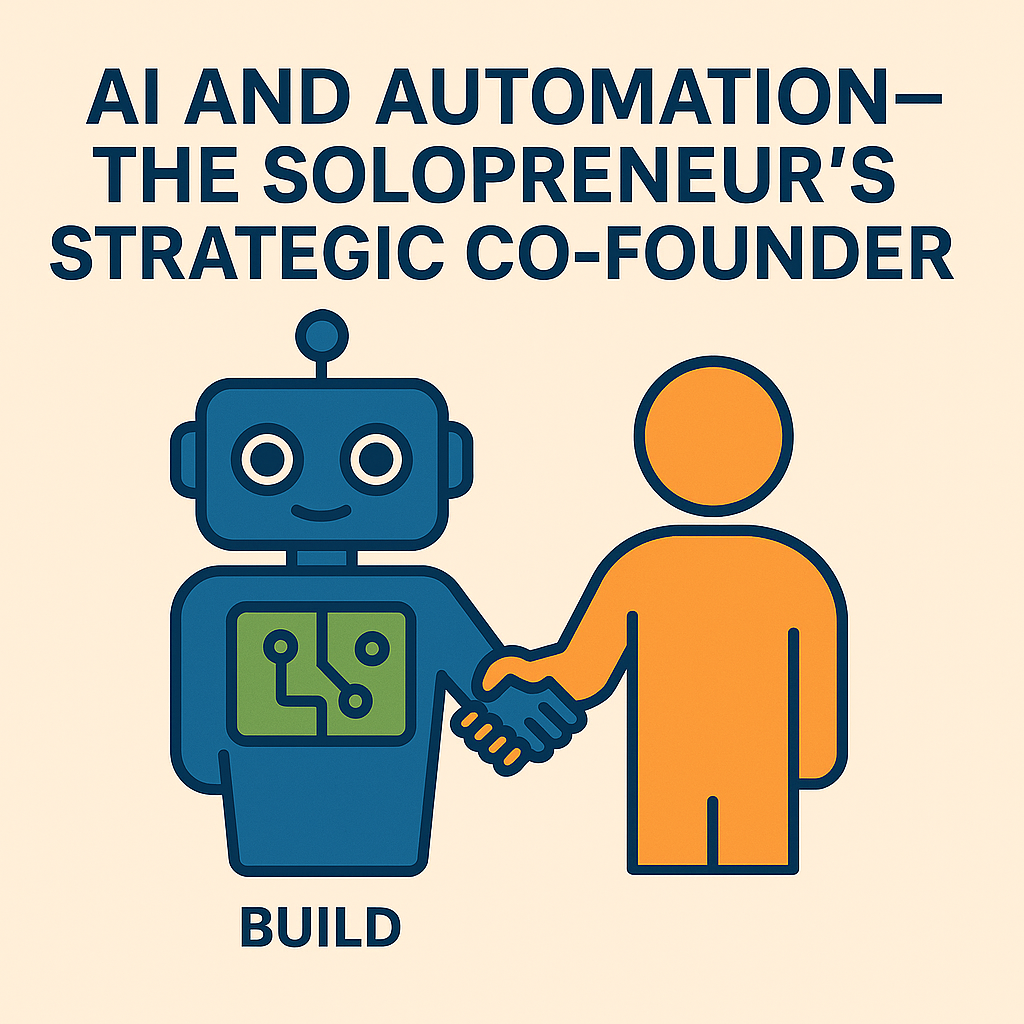If you’re a solopreneur, you face a brutal reality: your capacity is finite, but the market’s demands are infinite. Time spent writing emails, researching competitors, or prioritizing features is time taken directly away from high-leverage activities like selling or product development.
For the single founder navigating intense competition and resource constraints, artificial intelligence (AI) is not just a utility; it functions as a "strategic co-founder." It is the key ingredient that allows a single person to execute the entire four-week Solo Sprint framework.
This deliberate integration of AI and automation is the catalyst that supercharges the Lean Startup cycle, compressing processes that traditionally take months into a few short weeks. This effectively minimizes the greatest risks to a solo venture: wasted time and misallocated effort.
The Solopreneur’s New Team: AI and No-Code
The core concept of the Solo Sprint is that AI democratizes entrepreneurship. The integration of AI with no-code platforms gives the single founder the capabilities of a small, agile team, eliminating the need to hire or manage a costly full-time staff.
This ecosystem provides the single founder with five critical capabilities:
Instant Strategic Clarity: Tools like AI Startup Mentors (e.g., ValidatorAI) act as an overarching guide. You can pressure-test your idea, refine your business hypothesis, and prioritize essential features before you build. This is the Strategy Consultant you can afford on day one.
Rapid Development: No-code platforms (e.g., Softr, Bubble) allow non-technical founders to build a functional MVP (the Full-Stack Developer role) in days, transforming the founder into a system architect who connects pre-built components visually.
Automated Operations: Visual Orchestration Platforms (e.g., Make.com, Zapier) allow a solopreneur to connect disparate AI tools, systems, and CRMs via a no-code interface. This enables the automation of entire business processes, such as content creation workflows or lead qualification, effectively building a "virtual team."
Data Synthesis: AI agents can handle the Data Analyst role by performing real-time sentiment analysis on open-ended feedback, summarizing customer churn reasons, and quickly identifying patterns in raw usage data.
Relentless Content: Generative AI tools (e.g., Copy.ai) become your Copywriter/Marketer, churning out high-converting headlines, email sequences, and social media posts, all tailored to the ICP defined in Week 1.
The central shift is profound: the core challenge is no longer about technical skills (like coding), but about the founder’s ability to think strategically, validate ideas, and manage the project. Speed, decision-making, and accessibility are now more valuable than traditional coding knowledge.
Strategic Prompts: The Interface to Intelligence
If AI is the co-founder, then the AI Prompt Library is the critical interface for managing that co-founder. For the Lean solopreneur, a prompt must be viewed as the "minimum viable instruction" required to generate a meaningful, strategic output from the AI.
These are not just for generating paragraphs; they are for generating strategic clarity and actionable plans at every stage of the sprint:
By using these structured prompts, the founder outsources the heavy lifting of research, synthesis, and even light development, ensuring that every hour of the Solo Sprint is spent on high-leverage strategic work.
AI Automating the Build-Measure-Learn Loop
The Solo Sprint's success is defined by the speed of its Build-Measure-Learn cycle. AI’s greatest contribution is compressing the "Measure" and "Learn" phases, which traditionally consume massive amounts of human time.
Automated Measurement: AI-powered analytics tools move beyond basic page views to track meaningful Activation (users completing core tasks) and Retention (users returning). This gives the founder clear, actionable data, not just vanity metrics.
Automated Analysis and Learning: This is where the orchestration tools shine.
A system can be built where: User submits cancellation survey Make.com triggers an AI agent The AI agent categorizes the cancellation reason (e.g., "Too Expensive," "Lacking Feature X") The AI agent summarizes the top 3 reasons and adds them to a weekly review document.
This instant analysis frees the founder from manually crunching spreadsheets, allowing them to jump immediately to the Decide phase of the OODA Loop.
The result is an entrepreneurial engine capable of completing a full iteration (from idea to data-driven product change) in as little as 7-10 days—a speed unmatched by traditional small teams.
The Solopreneur’s Personal Sustainability Loop
The Solo Sprint is intense, and the single greatest non-technical risk to the solo founder is burnout and decision fatigue. While AI automates the product's feedback loop, the founder still requires a personal mechanism for sustainability.
This is solved by adopting the "Solopreneur's Weekly Review," a dedicated personal feedback loop designed to prevent exhaustion and maintain focus. During this 90-minute session, the founder assesses four areas to ensure they are focusing on high-leverage "10,000 Work" (strategic decisions) and avoiding low-leverage "busy work" (operational tasks that can be automated).
Wins & Results (Observe): What concrete, measurable metrics were achieved this week? What did the analytics tell me about the MVP?
Alignment (Orient): Are my current tasks and energy levels aligned with the core business hypothesis? Am I feeling motivated, or am I stuck in low-value work?
Pivot (Decide): Based on the product data and my energy, what is the single highest-priority experiment for the coming week? What is the one thing I must build or test next?
Action (Act): Plan the three non-negotiable "Bouts" (90-minute deep focus blocks) for the next day/week, ensuring they are dedicated only to the Pivot decision.
This practice is essential for directing energy toward the highest-impact work, ensuring the founder's own sustainability throughout the process.
The Solo Sprint framework is the ultimate system for speed, risk reduction, and validated learning. By treating your startup like a disciplined, four-week experiment and leveraging AI as your strategic co-founder, you can move from idea to paying customers in 30 days.
You have the framework. You have the tools. Are you ready to start your Solo Sprint?

No comments yet
Be the first to share your thoughts on this article!